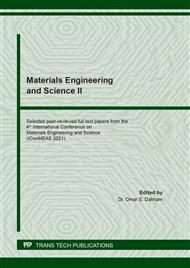p.3
p.9
p.17
p.27
p.33
p.40
p.49
p.55
Studying the Effect of Hydroxyapatite Coating on the Properties of Alumina
Abstract:
The expansion in the application of bio-materials leads to a wide variety of forms. The current study includes the preparation of a biological material in the form of a bio-coating that is represented by the, combination of a substrate with biological properties and at the same time high mechanical properties represented by alumina and the use of a coating from a material that provides high biological properties and low mechanical properties if it compared with the substrate, which is the hydroxyapeptite . Hydroxyapeptite was prepared from the biological waste, which is the egg shells after chemically cleaning by acetone solution and drying them in air , grind for 14 hours then calcination at 850 Co for 2hours, and reacting with phosphoric acid ,heat treatment by sintering at 1100Co, for 3 hours to obtain the pure hydroxyapatite phase. After preparing cylindrical samples of alumina and sintering them at a temperature of 1300°C and coating them by immersion with a solution of hydroxyapeptite prepared from mixing of hydroxyapeptite with of distilled water, the immersion is done at intervals ranging from (10,30,and 50 ) minutes, sintering process for soaking sample has been done at 1200 Co for one hours. The XRD and EDS technique showed an increase in the proportion of hydroxyapatite coatings formed and appears in calcium and phosphorous ions with an increase in the immersion time. Degradation test has been done after soaked the samples in Buffer solution for 7 days which proved increment in degradation as the soaking time increase .
Info:
Periodical:
Pages:
27-32
Citation:
Online since:
February 2022
Authors:
Keywords:
Price:
Сopyright:
© 2022 Trans Tech Publications Ltd. All Rights Reserved
Share:
Citation:


